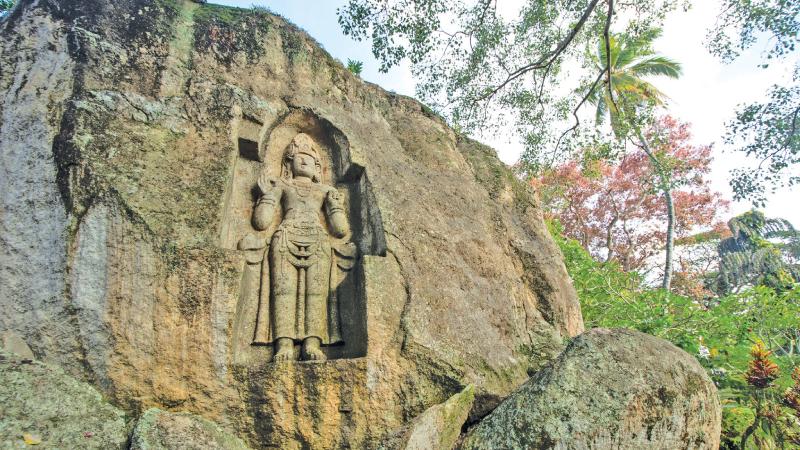
Though Weligama is a drowsy small sea town today, in the colonial period it was a highly prosperous centre for foreign trade. The 16th century lace-making craft which was introduced by the Portuguese still remains in some parts of the coastal area of Weligama. 
We spotted a few old buildings here and there which had columns with lattice work and were the only remnants of the colonial period in Weligama.
Ancient archaeological site
The magnificent ancient Kustarajagala archaeological site is within the hustle and bustle of the Weligama town close to the Aggrabodhi Vihara off the old Colombo Road.
Urbanisation has engulfed the surroundings of the Kustarajagala which is confined to a cramped small plot of land today.
Bodhisattva statue
The Kustarajagala rock cut statue is about 15 feet in height and stands on an isolated rock. An intricately carved and elaborately dressed splendid statue of the Bodhisattva is set deep into the rock. It lies in the shade of an overhanging Bo-tree. When we came to the site, rays of sunlight were flickering through the branches of the Bo-tree.
Perhaps, a huge rock boulder has been sliced in two to create this work. The other half lies on the opposite side, wrapped within the roots of an ancient Bo-tree.
Since the statue was carved into the rock at a higher elevation, we can view it above the eye level at about eight feet from the ground. After climbing the opposite rock, we came up to eye level with the statue.
From this point, the whole statue seems different and every detail becomes clear. Then, we realised the massive scale of the statue.
Legends
Known as Kustaraja, the statue was created between the 7-8th centuries according to the notice erected by the Department of Archaeology. There are various legends associated with the name and the construction of the statue. An ancient chronicle records that King Aggrabodhi IV (667-683 AD), suffered from an incurable skin disease and had got this sculpture made under his patronage. Since Aggrabodhi IV lived in Ruhuna for a long time he may have constructed this statue.
Details
Looking closely at the details of this rock hewn statue, we came across several features.
The statue is heavily draped in elaborate ornaments and cloths. The head dress too is elaborately designed with four figures of the Buddha carved on three sides of it. Many necklaces adorn the neck.
Parts of the head dress touch the shoulders. Perhaps this, one of the most beautiful and intricately carved statues in Sri Lanka suggests the influence of Mahayana Buddhism in the country in the 7-8th centuries.
Tragically, someone has attempted to dig out an area between the chest and the waist of the statue removing a piece of rock which contained an elaborately carved ornamental design across the statue.
Several similar marks are found in the head-dress of the Kustarajagala statue which is also believed to represent a Bodhisattva. Avalokitesvara is assigned a higher status than Maitreya by the Mahayanists.
He is identified as Natha Deviyo and is said to represent the influence of Hindu pantheism in Sri Lanka.
The left hand of the statue’s ring finger and middle finger are bent to touch the palm of the hand. This Mudra (pose) is believed to signify a beckoning to devotees for a blessing.
Nearby, the Aggrabodhi Rajamaha Vihara is the place where one of the first 32 saplings of the Sri Maha Bodhiya at Anuradhapura was planted.
It is also speculated that this Vihara was called Aggrabodhi since it was constructed under the patronage of King Aggrabodhi IV.
If you have some extra time on your hands on a trip to Weligama, do not forget to see the statue.
